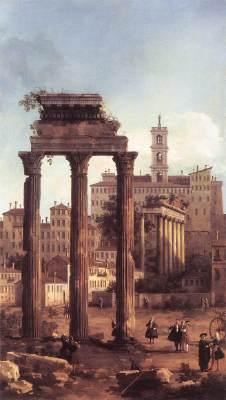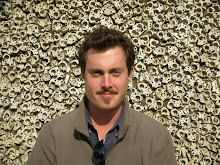 I told Murray that Albert Speer wanted to build structures that would decay gloriously, impressively, like Roman ruins. No rusty hulks or gnarled steel slums. He knew that Hitler would be in favor of anything that might astonish posterity. He did a drawing of a Reich structure that was to be built of special materials, allowing it to crumble romantically--a drawing of fallen walls, half columns furled in wisteria. The ruin is built into the creation, I said, which shows a certain nostalgia behind the power principle, or a tendency to organize the longings of future generations.
I told Murray that Albert Speer wanted to build structures that would decay gloriously, impressively, like Roman ruins. No rusty hulks or gnarled steel slums. He knew that Hitler would be in favor of anything that might astonish posterity. He did a drawing of a Reich structure that was to be built of special materials, allowing it to crumble romantically--a drawing of fallen walls, half columns furled in wisteria. The ruin is built into the creation, I said, which shows a certain nostalgia behind the power principle, or a tendency to organize the longings of future generations.Murray said, "I don't trust anybody's nostalgia but my own. Nostalgia is a product of dissatisfaction and rage. It's a settling of grievances between the present and the past. The more powerful the nostalgia, the closer you come to violence. War is the form nostalgia takes when men are hard-pressed to say something good about their country."
--From White Noise, by Don DeLillo
The Alamo, 1999
It seems like just a little old building, and I guess that's all it was. Is. For some reason I expect John Wayne and a coonskin cap, maybe Jim Bowie or Sam Houston as Disney animatronics telling us about the history of the Little Church That Didn't. For a famous last stand it seems oddly placed near the center of downtown San Antonio, close to a Riverwalk I remember from a strange mid-80's Dabney Coleman flick called Cloak & Dagger. We smoke a bowl in the car and have massive cheeseburgers at a chain restaurant featuring a full side of beef hanging in a windowed butchery at the entrance. Once finished with our half-pounders we get back on the road, back to New Orleans, passing along the way a pickup truck loaded with random wooden frames and cushioned furniture. A Tex-Mex father and son grin and wave at us from the loveseat situated cabside in the truck's bed. The father's longish hair blows down on his forehead before he sweeps it back, an effort in vain riding backwards at 80 mph, as he sips intermittently from a paper bag.
Wrigley Field, 1992
The moms bro sis and I are sitting on the third-base line, watching Ryne Sandberg and the Cubs beat the Astros. My sister claims Sandberg as her favorite player, but given that she's a girl and he's one of my own favorites, I assume H. is just trying to keep up with her brothers. It's my fifth or sixth Major League game, the first that doesn't feature the Cincinnati Reds playing at Riverfront. I can smell the Old Style steaming off the skin of the men in front of us, sick-sweet and maybe a false memory. The famous ivy on the outfield wall is too far away to bear any significant odor, but it looks like it smells green, like fresh money or the hide of a lime rhino. My brother and I try to get into the outfield bleachers late in the game, on an ivy-smelling sensory expedition all our own, and are stopped at the entrance by a man asking for tickets. Wrigley sells out, it seems, even in the early afternoon on a weekday. We walk back to our assigned seats under exposed pipes, big enough to fit a man and hanging fifty feet in the air, as the streetside sunlight cuts visible swaths through the steam rising off every Polish sausage stand.
Keeneland, 2006
Ten years have passed since I last visited the track on a Friday-afternoon bailout from high school. This time around we are old enough to drink overpriced beer and syrupy mint juleps bearing only a name in common with any proper execution of the cocktail. We sip and talk and laugh and bet and lose, though not necessarily in that order. An early morning's jump on the afternoon garners the industrious (we are not among them) a prime seat on the paddock green, a place to throw the blanket, park the cooler, claim a small tract of Bluegrass in the name of whichever sovereign one might choose. Kings Miller and Budweiser rule the day. After the simulcast Derby ends on the Jumbotron and we throng out to the rolling parking pastures, anyone near the fourth turn has a view of the jumbo jet parked at the airport across Versailles Road, the flag of the United Arab Emirates emblazoned on its tailfin. Some sheikh or sultan must have named Lexington the stopping-off point for his bulletproof limo on the way to Friday's Oaks and the big race on Saturday. I wonder if our racetrack's gables and cupolas are visible from the jet's port windows.
Gulf Shores, 2001
Due south of G.S., on a sandbar that might not exist anymore, I'm walking in a stiff, salty breeze with a girl I don't even know. It's past midnight and we're both naked to the waist. Three hours previous, I liberated a bottle of fine German doppelkorn from my workplace and hopped in a beater Saturn with a mysterious brunette and an obese, epileptic golden Labrador. I have known the girl for a week and the dog for the three-hour drive. The girl and I walk, we talk, we drink from the bottle while her dog barks at the surf. We eventually make it back to her family's place on the beach and she promises me we'll go crabbing in the morning, maybe take the jet-ski out on the lagoon side of the sand. We're lying on the couch later and she tells me she's been studying a little shiatsu, asks me to lie back in her lap. She applies a dime's weight beneath her fingertips upon my temples, my earlobes, under my chin, and we both fall asleep listening to the stereo's dying gasps of anonymous jazz. I awake with a start hours later, turn around to find her still sleeping, carry her to bed. We spend the morning doing what people do, disregarding the shades' arrhythmic flapping in the offshore wind.
Bled, 2005
Staying with some newfound friends in Slovenia, I hop a ride to a tiny subalpine lake in the Julian Alps. My guidebook tells me a tiny island in the middle is home to a chapel with a bell that grants the ringer seven years of good luck. So we go to the lake, and we dive from the pier, and we swim the kilometer across to the island, and we walk up the stony path leading from the shoreline to the chapel. And when we get to the chapel, my friends--both Catholics--tell me they'll wait for me in June's diamondbright sunshine, out of a reverent deference to God and to the signs posted that outlaw the entrance of anyone in swimming shorts and bare feet. They leave to me any decision to transgress upon what might be God's own law, in God's own house, on a foolish quest for some rumored modicum of good fortune. Possessing no belief in any divine being, yet ironically possessed of a desire for the divine benefits of said bell-ringing, I scamper into the chapel and jump as high as I can, grabbing the rope and pulling it down with all my weight. When I land again on the stone floor, I leave little wet toeprints behind me as I hightail it out the side entrance. The bell rings for about a minute. As we swim back I'm nearly cut in half by Slovenia's local Olympic sculler knocking out laps in his razorboat. Every soda cap still reads "Please Try Again."
Canyon de Chelly, 2004
I begin the hike down the canyon's side to the White House at 7 AM, after a preliminary peanut butter sandwich watching the Arizona sunrise on the drive up. My camera bag holds three lenses and seven filters, my tripod rests on my shoulder, and my water bottle burbles in anticipation of a full morning's trek. On the way down I stop to photograph the whorls of sandstone on the smooth face of the canyon, trying to catch the alternating red orange yellow gold glinting in the morning sun. Dry desert air blows chill, not yet warmed beneath the rim as I follow the trail to the green canyon floor, onto the Navajo sheep farm where a sign is posted: "No Photographs Please Respect The Inhabitants And Pick Up All Trash." I see the sheep and two Inhabitants and I wave, but they don't even mark my presence. I continue across the bottom to the opposite cliff face, still in shadow awaiting the afternoon's sun. As I look up at the 800-year-old Anasazi ruin, I notice the Native American couple bowing and kneeling at the chain-link fence that separates tourists from the cliff dwelling. The couple are keening, a term I mentally apply to their singing supplications although I know it only from an Irish play I read and forgot years ago. Perhaps they're merely praying. I sit forty yards behind them for thirty minutes, maybe more, when a French family comes singsonging down the trail behind me. We are the only four people in that part of the canyon who have no right to be there, and I hold up a hand offering a universal stop sign, SVP, merci. They cut their conversation tout court and sit with me in the dust. We wait, silently, for words we will never understand to finish echoing from the ancient home with "Adams US Cav 1879" carved into its otherwise still-white façade.
